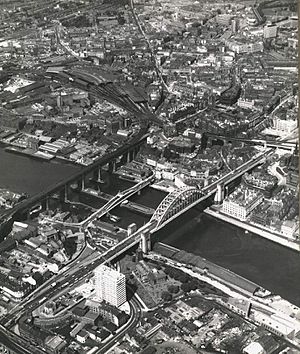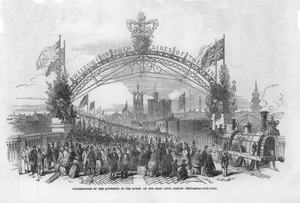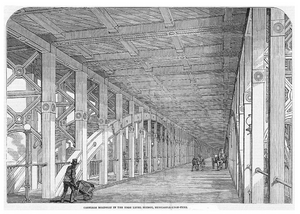Hawks family facts for kids
Quick facts for kids Hawks |
|
|---|---|
| Current region | |
| Members |
|
| Connected members |
|
| Estate(s) | Pembroke Square, Kensington |
|
One of the most powerful British industrial dynasties of the British Industrial Revolution. The Hawks owned iron manufacture and engineering companies in Northern England and in the City of London that employed over 2000 people and that exported worldwide using their own ships.
|
|
The Hawks family (c.1750 – 1889) was a very powerful family during Britain's Industrial Revolution. They owned big companies that made iron and engineered amazing things. Their businesses, like Hawks and Co., were in Northern England and London. They built bridges, ships, and other important structures.
The Hawks family also worked in merchant banking (helping businesses with money). They were involved in freemasonry, which is a social and charitable organization. They also supported Whig politics, which focused on free trade. The family even helped develop parts of London, including Pembroke Square in Kensington.
The Hawks family was most powerful during the Victorian period. At their peak, they employed over 2000 people. They were famous worldwide for their engineering skills, especially in bridge-building. Their factories in Gateshead were so big they were called New Deptford and New Woolwich.
They built the famous High Level Bridge over the River Tyne. Queen Victoria herself opened this bridge in 1849. The Hawks also built bridges in places like Constantinople (now Istanbul) and India. They made lighthouses in France and ironclad warships for the Royal Navy. They even had big contracts with the East India Company. In 1821, the Hawks company built the first ever iron boat, called the Vulcan.
Some important members of the family included Sir Robert Shafto Hawks, Joseph Hawks (a banker and Sheriff of Newcastle), and George Hawks (a leader in Freemasonry and Mayor of Gateshead). Mary Hawks married Richard Clement Moody, who founded British Columbia. Colonel Richard Stanley Hawks Moody was a respected British Army officer. The poet Joseph Skipsey once worked at the Hawks' ironworks in Gateshead.
Contents
Hawks Family Businesses
The Hawks company was started by William Hawks (1708 – 1755). He set up workshops along the river in Gateshead in the late 1740s. When he died, his son, also named William Hawks (1730 - 1810), took over. This younger William, with his wife Elizabeth Dixon, helped build the family's international business empire.
In 1770, William (d. 1810) partnered with Thomas Longridge. They bought a metalworking factory in Beamish, County Durham. This was the first of several metalworking sites they operated. Later, they acquired more factories in County Durham and Northumberland.
By 1790, their Gateshead factories were a huge industrial complex. They made steel, anchors, heavy chains, and parts for steam engines. They supplied these products to the Board of Admiralty (which managed the Royal Navy). The Hawks family also owned the Bedlington Ironworks for a time.
In the 1830s, the Hawks Company built Hawks Cottages in Gateshead for their workers. This showed their commitment to their employees.
In 1810, William Hawks's estate was passed to his sons: George Hawks, Sir Robert Shafto Hawks, and John Hawks. By the late 1830s, the Hawks' factories covered 44 acres and employed 800 to 900 people. By 1863, they employed 1500 people. They had many powerful engines and furnaces. The poet Joseph Skipsey worked at the Gateshead ironworks from 1859 to 1863. He got the job through James Thomas Clephan, who edited the Gateshead Observer newspaper.
The Hawks' New Greenwich ironworks in Gateshead was the biggest employer in Newcastle. However, the company, known as Hawks, Crawshay, and Sons, closed down in 1889.
Amazing Products and Projects
The Vulcan: First Iron Boat
In 1821, the Hawks' ironworks built the very first iron boat. It was a rowing boat named the Vulcan. When Sir Robert Shafto Hawks heard about the inventor's plan, he gave him the iron for free! Cannons were even fired when the boat was launched. The Vulcan won races against wooden boats of the same size. Sadly, in 1826, the Vulcan was involved in an accident with a steam vessel. Two rowers died, and the boat was later abandoned.
Other Famous Creations
Around 1842, the Hawks company built a cast-iron bridge in York over the Ouse. It had a single arch 172 feet wide. They also rebuilt the Rowland Burdon iron bridge in Sunderland, Tyne and Wear. This bridge had a single arch 237 feet wide.
The company also made wrought iron gates for the Northumberland Docks. They built iron lighthouses in places like Gunfleet, Harwich, and Calais. They even constructed an iron pier in Madras (now Chennai, India) and bridges in Constantinople. Sir Robert Hawks helped pay for St John's Church, Gateshead Fell.
The Hawks company built the amazing High Level Bridge over the Tyne. It used 5050 tons of iron! George Hawks drove in the last key on June 7, 1849. Queen Victoria officially opened it later that year.
During the Napoleonic Wars, the company produced ironclad warships and other important materials for the Royal Navy. They also had large contracts with the East India Company. They built paddle steamers and hydraulic dredgers for use in Britain.
Property Development
The Hawks family also helped develop parts of London. This included Pembroke Square in Kensington.
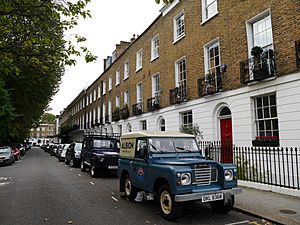
Key Family Members
Sir Robert Shafto Hawks (1768 - 1840)
Robert Shafto Hawks became the head of the Hawks company after his father died. He was knighted by the Prince Regent in 1817 for stopping riots. Sir Robert was involved in freemasonry, where he held an important leadership role. He is remembered in Newcastle Cathedral.
Sir Robert married Hannah Pembroke Akenhead in 1790. They had two sons. One son, William, became a church minister. The other son, David, was blind but a musical genius. At just 9 years old, he composed music for military bands. People said he had "amazing proof of musical genius."
George Hawks (1801 - 1863)
Sir Robert's nephew, George Hawks, took over as director of the company. George was a strong supporter of Sir William Hutt MP, a politician from Gateshead. George Hawks was the first Mayor of Gateshead in 1836. He served as mayor again in 1848 and 1849.
George Hawks was very involved in freemasonry. He was a Grand Master of a major Masonic group. He was described as "an excellent mason."
Joseph Hawks (1791 - 1873)
Joseph Stanley Hawks was Sir Robert Shafto Hawks's nephew. He was a merchant banker and served as Sheriff of Newcastle. He married Mary Elizabeth Boyd, whose family had founded the Bank of Newcastle.
Mary Hawks (later Moody) (b. 1829)
Joseph's daughter, Mary Susannah Hawks, married Richard Clement Moody. He was famous for founding British Columbia in Canada. Richard Clement Moody named a 400-foot hill in Port Coquitlam, Canada, "Mary Hill" after his wife. The Royal British Columbia Museum has 42 letters written by Mary Moody. These letters, sent from British Columbia to her mother and sister in England, are very interesting to historians.
Richard Stanley Hawks Moody (1854 - 1930)
Colonel Richard Stanley Hawks Moody was a distinguished British Army officer. He was also a historian and a Military Knight of Windsor.
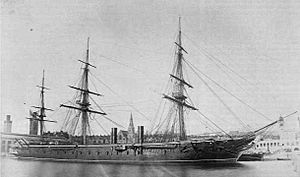
Decline of the Hawks Company
In 1840, Hannah, Lady Hawks (Sir Robert Shafto Hawks's widow), and her two sons sold their shares in the company. They sold them to George Crawshay, whose family was also famous for making iron. George Crawshay later bought more shares from Joseph Hawks.
The Bedlington works, another part of the family business, was inherited by a cousin, Michael Longridge. He was a pioneer in railway technology and worked with Robert Stephenson, a famous engineer.
In its final years, the Hawks, Crawshay and Sons company was managed by George Crawshay (1821 – 1896), the son of the elder George Crawshay. Unlike George Hawks, this George Crawshay did not manage the company well. He failed to update the company's methods. Other specialist companies, like those owned by William Armstrong, 1st Baron Armstrong, became more successful. The Hawks' company's profits dropped, and it eventually closed down in 1889. All its debts were paid, but its old records were destroyed.


